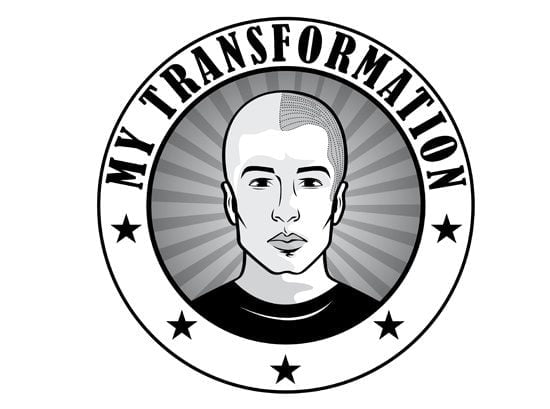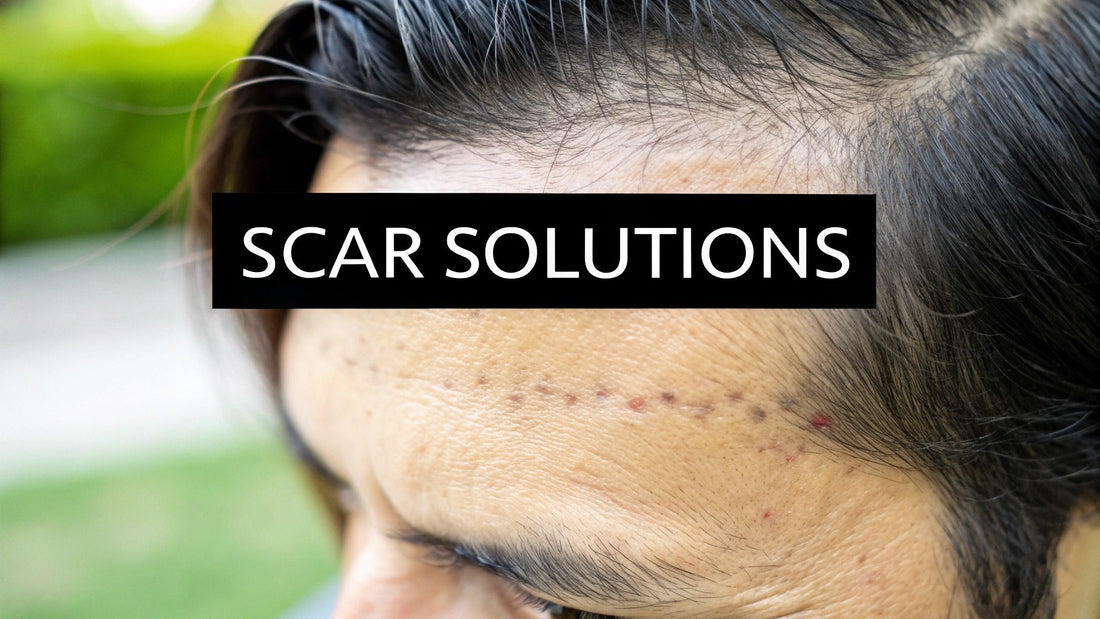
Your Guide to Hair Implant Scar Solutions
Share
Let's get one thing straight from the outset: any hair transplant surgery will leave a scar. It's an unavoidable part of the process. However, the key takeaway is that modern techniques have made these scars incredibly subtle, a world away from the obvious plugs of the past.
The real difference lies in how the donor hair is collected. This choice leads to two very different types of scarring: a single, fine linear scar from a Follicular Unit Transplantation (FUT) procedure, or thousands of tiny, scattered dot-like scars from Follicular Unit Extraction (FUE). Knowing the difference is crucial for setting realistic expectations and picking the right path for you.
Understanding Scars from Hair Transplants
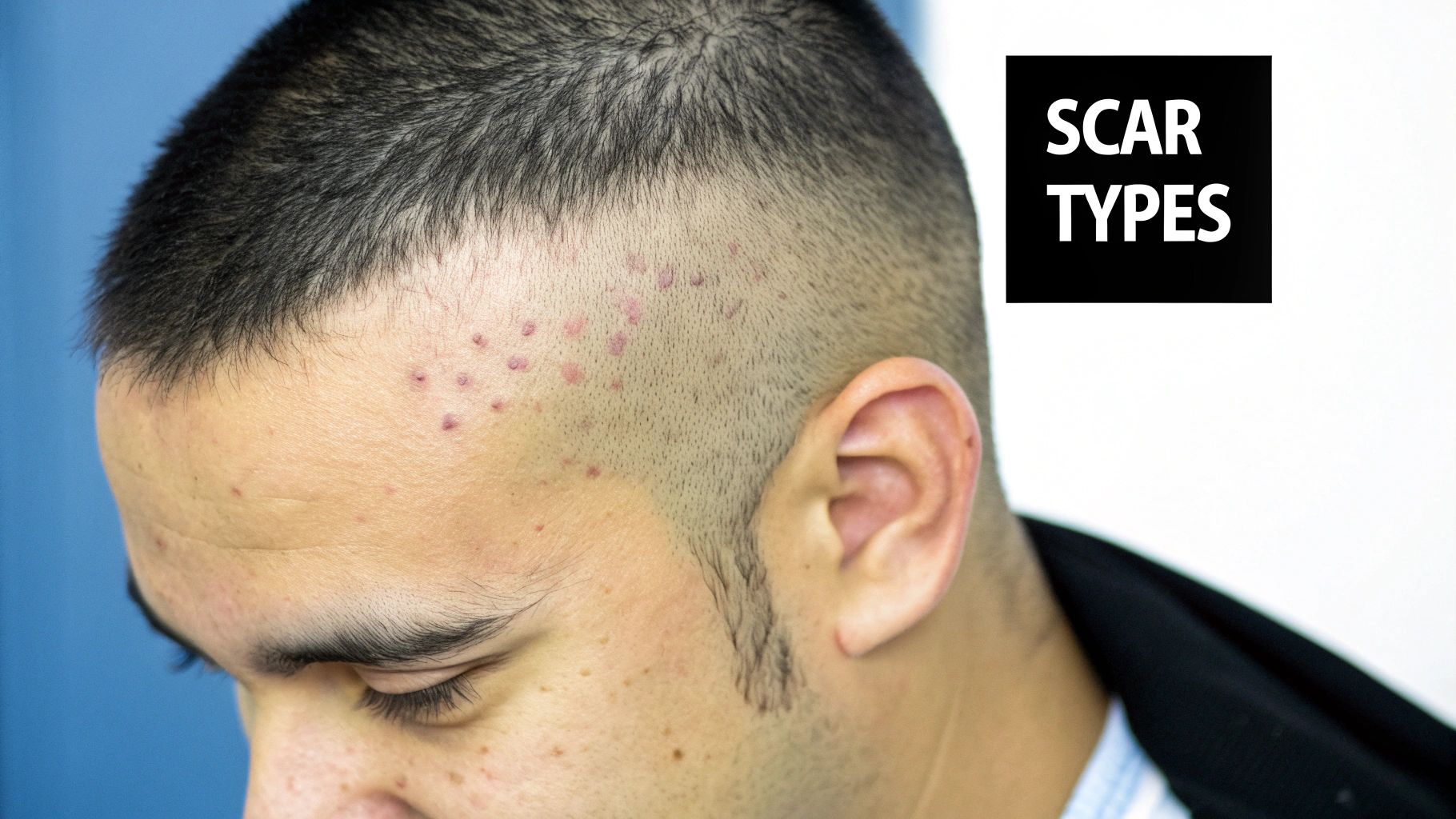
The word "scar" can be intimidating, especially when you're already looking for a confidence boost. But it’s important to remember that not all scars are the same. The type of hair implant scar you end up with is a direct result of the surgical method used to harvest the donor follicles from the back and sides of your head.
Think of it like this: imagine you need to patch a lawn. You could cut a neat strip of turf from a healthy area, which leaves a single, clean line behind. Or, you could meticulously dig up individual plugs of grass from all over the lawn, leaving behind small, spaced-out holes. Both methods work, but they leave a very different visual footprint. That's the fundamental difference between the two main hair transplant techniques.
The Two Main Types of Hair Transplant Scars
To really understand what you're dealing with, we need to break down the scars by procedure. Each one leaves its own signature on the scalp, which can influence everything from your future hairstyle choices to whether you'll need any concealment down the track.
-
Linear Scars (from the FUT Method): This is the classic scar from a Follicular Unit Transplantation (FUT) procedure, often called the "strip" method. The surgeon removes a thin strip of scalp tissue from the donor area and then stitches the wound closed. This leaves a single, fine horizontal scar that’s usually well-hidden by the surrounding hair, provided you don't wear it in a super-short buzz cut.
-
Punctate Scars (from the FUE Method): These are the tell-tale signs of Follicular Unit Extraction (FUE). Instead of taking a whole strip, the surgeon removes individual follicular units one by one with a tiny, circular punch tool. This leaves behind hundreds or thousands of small, round scars that look like faint dots scattered across the donor area.
The big selling point for FUE is that these tiny dot scars are much harder to spot, especially with very short hairstyles, because there's no single, continuous line.
No matter which procedure you choose, the final look of your scar comes down to a few key things: your surgeon's skill, your body's personal healing ability, and how well you follow the after-care instructions. And the good news? Even if a scar is more visible than you’d like, amazing solutions like Scalp Micropigmentation (SMP) can camouflage it brilliantly, giving you back that complete confidence.
Why FUE and FUT Procedures Leave Different Scars
To really get your head around hair implant scars, you have to know their origin story. Every single scar is a direct result of how the donor hair follicles were harvested in the first place. The two main techniques, Follicular Unit Transplantation (FUT) and Follicular Unit Extraction (FUE), are worlds apart in their approach, and that difference is literally etched onto the scalp in their unique scarring patterns.
Think of it like a gardener moving plants. The FUT method is like cutting out a whole rectangular strip of turf to place somewhere else. FUE, on the other hand, is like using a tiny trowel to carefully dig up individual plants one by one from all over the garden. Both get the job done, but the marks they leave behind are completely different. That’s the core distinction right there.
This infographic gives you a great visual breakdown of the linear scar from a FUT procedure versus the tiny micro-scars from FUE.
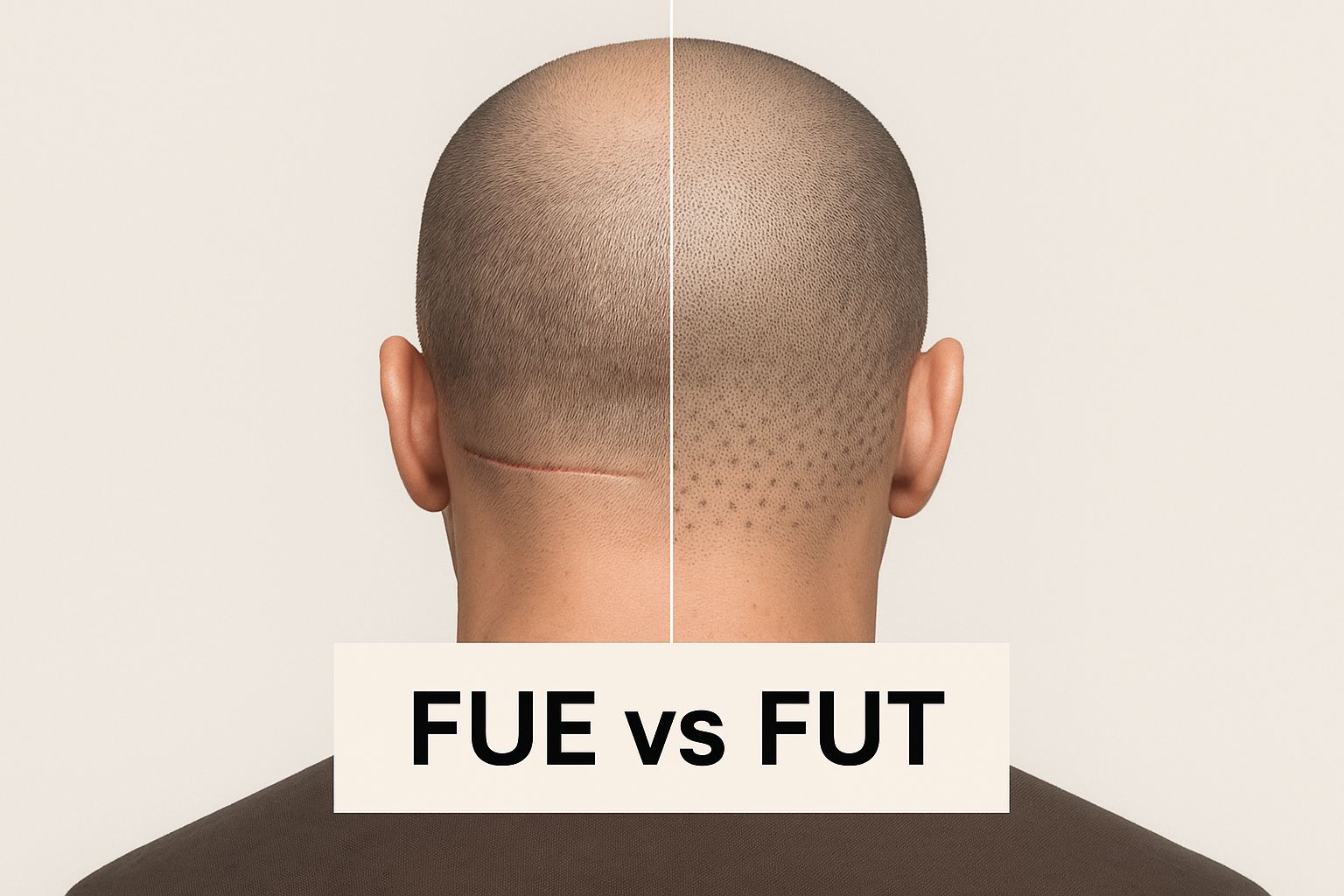
As you can see, the choice of procedure is the single biggest factor in determining whether you end up with one concentrated scar or hundreds of tiny, scattered ones.
The FUT Method and Its Linear Scar
Follicular Unit Transplantation, often called the "strip method," is the older, more traditional technique. During a FUT procedure, the surgeon removes a thin, linear strip of scalp tissue from the donor area—usually the back of the head, where hair is naturally more resistant to balding.
That strip, which is packed with healthy hair follicles, is then passed to a technical team. They meticulously dissect it under high-powered microscopes to separate individual follicular units, ready for implantation. While they're doing that, the surgeon closes the wound with sutures or staples. This closure is what leaves the single, fine linear scar. Its length and width depend on how many grafts were taken, but a good surgeon will place it strategically so it's easily hidden by the surrounding hair.
The FUE Method and Its Punctate Scars
Follicular Unit Extraction is a much more modern and less invasive approach. Instead of taking a whole strip of tissue, the surgeon uses a specialised micro-punch tool, typically less than 1 mm in diameter, to extract individual follicular units directly from the scalp.
This is done over and over, sometimes hundreds or even thousands of times, across a much wider donor area. Each little extraction leaves a tiny circular wound that heals into a small, dot-like scar. We often call these punctate scars.
Because these scars are so small and scattered, they are far less noticeable than a single linear scar. This is a huge plus for anyone who likes to wear their hair short, like a buzz cut, without giving away that they've had a procedure.
To give you a better side-by-side view, here's a simple comparison of the scarring characteristics for each method.
Comparing FUT and FUE Scarring Characteristics
| Characteristic | FUT (Strip Method) | FUE (Extraction Method) |
|---|---|---|
| Scar Type | Single, linear scar. | Multiple tiny, dot-like scars. |
| Scar Size | Can be several inches long; width varies but can be up to 10 mm. | Each scar is typically less than 1 mm in diameter. |
| Visibility | Noticeable with very short hair; requires longer hair for concealment. | Very difficult to detect, even with short or shaved hairstyles. |
| Location | Concentrated in one line at the back or side of the head. | Scattered across a wide donor area. |
Ultimately, the choice comes down to what you’re comfortable with.
The popularity of FUE is a massive reason why the Australian hair transplant market, valued at around AUD 230 million, continues to grow. People want these less invasive techniques that don't leave obvious scars, which is a major shift away from the wider linear scars that can sometimes result from FUT. You can read more about this trend in the latest Australian hair transplant market analysis.
Deciding between FUE and FUT involves balancing the type of scarring with other factors like cost and the number of grafts you need. Our detailed guide on what an FUE hair transplant involves can help you think through these options. But remember, the final look of any scar always comes down to two key things: the skill of your surgeon and how your own body heals.
Can New Hair Grow on Scar Tissue?
It’s one of the biggest questions on anyone's mind when they’re living with a scar from an old hair transplant: can you fix it with another one? The idea of simply implanting new hair right into the scar tissue sounds like the perfect do-over. While it’s not quite that simple, the answer is a qualified and hopeful yes. It just takes specialised techniques and a good dose of realistic expectations.
The main roadblock is a biological one: blood supply. Think of a healthy scalp as rich, fertile soil, packed with everything a seed needs to sprout. Scar tissue, on the other hand, is more like hard, compacted clay. It’s missing the dense network of tiny blood vessels that are crucial for delivering oxygen and nutrients to new hair grafts. This is why hair doesn't grow back on its own once a deep scar forms—the follicles are gone, and the ground is too tough for anything new to take root.
But that’s not the end of the story. The world of hair restoration has come a long way, and surgeons have developed incredible methods to tackle this exact problem. It's no longer a question of if you can grow hair on a scar, but how to do it effectively.
Overcoming the Biological Barrier
Top surgeons have figured out clever ways to turn that 'compacted clay' into a much more welcoming environment for new hair. It’s a delicate, skilful process that goes well beyond what’s required for a standard hair transplant.
Often, this starts with preparing the scar itself. A surgeon might use special techniques to soften the dense tissue and encourage new blood flow, essentially tilling the soil to make it more hospitable. The way the new follicles are implanted is also completely different.
Success in a scar transplant isn't just about placing the grafts; it's about placing them in a way that maximises their chance of survival. This means carefully controlling the angle, depth, and density to work with the unique texture of the scar tissue.
This specialised field has become a huge part of Australia’s hair restoration industry. Thanks to advances in Micro FUE and Direct Hair Implantation (DHI), highly skilled, doctor-led teams can now achieve permanent, natural-looking results in scarred areas—something that was once thought to be almost impossible. And to make these procedures more accessible, many leading Australian clinics now offer flexible payment plans. You can find more insights on transplanting on scars from hair restoration experts.
Setting Realistic Success Rates
It's crucial to have an honest chat about what you can realistically expect. While success is definitely on the table, the survival rate for hair grafts placed in scar tissue can be lower than in a healthy, untouched part of the scalp.
The final result really hinges on a few key factors:
- The scar itself: A thin, flat scar is a far better canvas than a thick, raised (keloid) one.
- The surgeon's skill: This isn't a job for just any clinic. You need a specialist with a proven track record in scar repair.
- Your body’s healing ability: Everyone's body is different, and your personal healing response plays a big part in how well the grafts take. To get a better idea of what's involved, it helps to understand the hair growth cycle.
While achieving full density on scar tissue can be a challenge, exploring different hair growth products can also help improve the health and density of the hair around the area. For the right person, a hair transplant onto a scar can deliver fantastic, life-changing results, blending the area seamlessly and restoring a natural hairline.
How to Minimise and Prevent Transplant Scars
Even though a hair transplant is a surgical procedure, you actually have a surprising amount of say in how any scarring turns out. Think of it as a partnership: you need a skilled surgeon, but your commitment to the process is just as crucial. The steps you take before and after the procedure can make a massive difference, helping you achieve a result that looks completely natural.
Your journey to a barely-there scar starts well before you even walk into the clinic. It’s all about smart preparation, diligent aftercare, and trusting your body's ability to heal. If you nail these three areas—finding the right surgeon, prepping your body, and following aftercare to the letter—you can dramatically improve how your scalp recovers.
Choose Your Surgeon Wisely
This is, without a doubt, the most critical decision you'll make. A surgeon's skill, technique, and years of experience are what stand between a visible scar and one that's virtually undetectable. A great surgeon isn't just a technician; they're a bit of an artist, meticulously planning each incision to minimise trauma and blend seamlessly with your existing hair.
For an FUE procedure, a top-tier surgeon will use the smallest punch possible (often less than 0.8mm) and scatter the extractions so you don't end up with patchy spots or obvious scar clusters. With FUT, their expertise is all about the "tension-free closure." This technique is the secret to getting that fine, pencil-thin line that heals beautifully. Don't be shy about asking to see photos of their past patients' healed donor areas—that's where you'll see the real proof of their work.
Prepare Your Body for Optimal Healing
Think of your body as the canvas for the surgeon's work. Getting it into the best possible shape beforehand can seriously boost your healing. It’s a bit like an athlete prepping for a big match; you want your system primed to perform and recover efficiently.
This means making a few lifestyle tweaks in the weeks leading up to your surgery.
- Ditch Smoking and Vaping: Nicotine is a real problem for healing. It constricts your blood vessels, which chokes off the supply of oxygen and nutrients your skin desperately needs to repair itself. This can lead to slow healing and a much more noticeable scar.
- Skip the Alcohol: Alcohol can thin your blood and leave you dehydrated, neither of which helps recovery. It's best to avoid it for at least a week before and after your transplant.
- Power Up Your Nutrition: Fuel your body with everything it needs to rebuild. Focus on a diet packed with protein, Vitamin C (which is vital for creating collagen), and Zinc.
When you give your body the right fuel, you're setting the stage for a faster, cleaner healing process. A well-nourished body is simply better at repairing tissue and fighting inflammation, which all leads to a less obvious hair implant scar.
Commit to Meticulous Post-Operative Care
Once the surgeon has done their part, the baton is passed to you. Those first two weeks are absolutely critical. How you look after your donor area during this time will directly impact the final look of your scar. Your clinic will give you a detailed set of instructions—follow them religiously.
This means no cutting corners. You'll need to avoid any strenuous exercise, sweating, or letting the sun hit your scalp directly. Keeping the area clean according to their directions is also non-negotiable, as an infection can wreak havoc on scar formation. As you research, you might also come across the benefits of regenerative ingredients like GHK Copper Peptides for promoting better skin healing.
Good aftercare is also about patience. Scars don't just heal and disappear overnight; they evolve over months, slowly softening and fading. For a full breakdown of what to expect week by week, our guide on hair transplant recovery has you covered. By taking these steps seriously, you'll ensure your story is about the fantastic new hair on your head, not the scar left behind.
Effective Ways to Conceal Hair Implant Scars
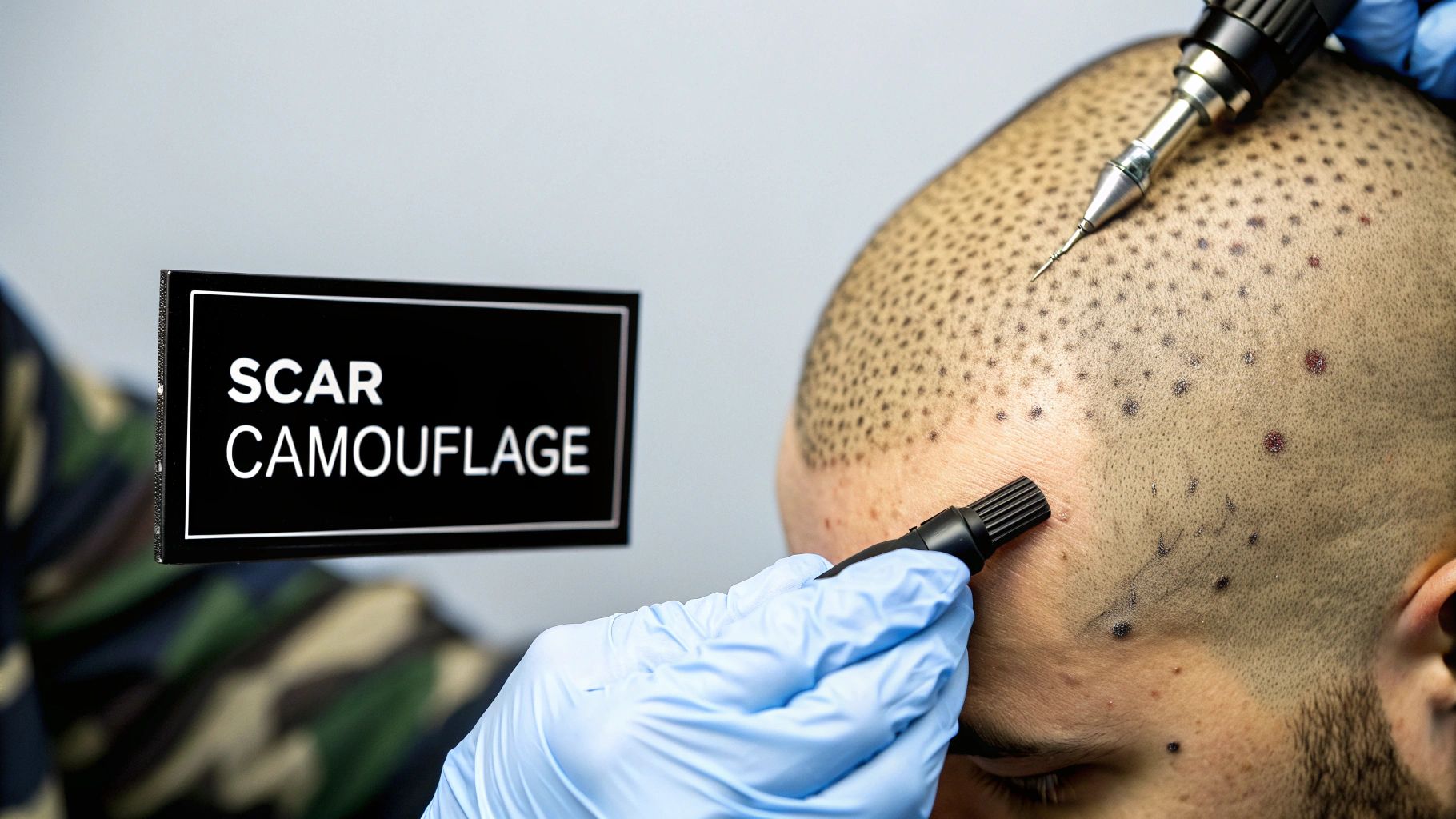
If a hair implant scar is knocking your confidence, the good news is you have more options today than ever before. While prevention and good healing are crucial, a whole range of concealment and revision techniques can tackle existing scars head-on. You really don't have to just live with it.
From clever cosmetic tattooing to surgical solutions, there’s a path to making that scar a distant memory. The trick is to understand what each method actually involves, who it’s best suited for, and what kind of results you can realistically expect.
Scalp Micropigmentation for Ultimate Camouflage
Scalp Micropigmentation, or SMP, has become the gold standard for scar concealment, and for very good reason. It’s a highly specialised cosmetic tattooing technique where tiny dots of pigment are meticulously applied to the scalp, perfectly mimicking the look of natural, shorn hair follicles.
Think of it as artistic pointillism for your head. An expert SMP artist uses ultra-fine needles to deposit pigment into the upper dermis, building up density dot by dot. The result is a brilliant illusion that breaks up the scar's flat appearance, blending it seamlessly into the surrounding hair.
SMP is exceptionally effective for both FUT and FUE scars. It can fill in the pale, linear mark of a FUT scar or camouflage the scattered dot scars from an FUE procedure, making them virtually invisible, especially with shorter hairstyles.
This method doesn't actually remove the scar, but it camouflages it so well that it becomes incredibly difficult to spot. It’s a fantastic non-invasive solution with minimal downtime, offering a permanent fix for the visual side of a hair transplant scar. For those looking at a holistic approach, it's worth exploring how you can combine a hair tattoo with a hair transplant for a complete result.
Laser Treatments to Resurface Scar Tissue
If the texture or colour of your scar is the main problem, laser treatments can be a fantastic option. These procedures use focused light energy to target and remodel the scar tissue from within, which can dramatically improve how it looks and feels.
There are a couple of different types of lasers your practitioner might use, each with a specific job.
- Ablative Lasers: These work by removing extremely thin layers of skin. This helps to flatten out any raised or bumpy scars and encourages the growth of smoother, healthier new skin in its place.
- Non-Ablative Lasers: This type of laser gently heats the underlying skin tissue without damaging the surface. This kick-starts collagen production deep down, which helps improve the scar's texture and can reduce stubborn redness.
Laser therapy usually requires a series of sessions to get the best outcome, but it can make a huge difference by making the scar flatter, softer, and much closer to your natural skin tone.
Surgical Scar Revision for Significant Scars
For wider or more prominent scars that can't be properly hidden with other methods, surgical scar revision might be the best way forward. This is a procedure where a plastic or hair transplant surgeon carefully removes the old scar tissue and then meticulously re-closes the incision.
The whole goal is to replace a noticeable scar with a much finer, less obvious one. A skilled surgeon can use advanced closure techniques, like a trichophytic closure, which is designed to allow hair to grow directly through the new, thinner scar line, providing incredible natural camouflage.
This is obviously a more invasive option and is typically reserved for more severe cases, like a stretched FUT scar. But for the right person, it can produce a dramatic and permanent improvement, making any other concealment efforts that much easier and more effective.
Who Seeks Hair Transplant Scar Treatments in Australia
If you're looking into treatments for a hair implant scar, you're definitely not alone. It might feel like a niche issue, but scar revision is a huge part of the hair restoration world in Australia, helping thousands of people get their confidence back every single year. The path to fixing or hiding a scar is a well-trodden one, shared by more people than you might think.
Often, the decision to get treatment comes down to wanting more freedom with hairstyles. This is especially true for those with the linear scars from FUT surgery who just want the option to wear their hair short without a second thought. For others, it’s about putting the finishing touch on their hair transplant, making sure the final result is as natural and undetectable as possible.
A Snapshot of Australian Patients
Here in Australia, the crowd seeking hair restoration is mostly male. The biggest groups are men between 30-39 years old (29.3%) and 40-49 years old (27.9%). These are guys often at the peak of their careers who want their look to match their energy and drive.
It's not just men, though. A growing number of women are also looking for solutions to address thinning hair or scarring from previous procedures. What this tells us is that the desire for a clean, scar-free scalp is universal—it doesn’t matter who you are.
Seeking treatment for a hair transplant scar isn't an admission of a failed procedure; it's often the final, perfecting step in a successful hair restoration journey. It’s about achieving a result that allows for complete confidence and versatility in personal style.
While general hair loss is what gets most people in the door, scar repair is a specialised and critical service within the industry. Looking at the global picture, about 1.9% of male and 2.6% of female patients are specifically seeking procedures to deal with scarring. And with hair transplant success rates in Australia sitting above 97%, it's clear that even tricky cases involving scar tissue can get fantastic results in the right hands. You can check out more detailed hair transplant statistics and trends to get the full story.
Ultimately, anyone who feels their scar is holding them back is a good candidate for treatment. This could be someone with an older FUT scar looking for a modern fix, or even someone wanting to blend the tiny dots from an FUE procedure for a truly flawless finish. The goal is always the same: to make the story about your hair, not the scar. For many, this means exploring advanced cosmetic options, and it’s worth understanding who can benefit from hair tattoos as a powerful way to conceal scars.
Common Questions About Hair Implant Scars
It's completely normal to have a heap of questions when you're looking into hair restoration, especially about what happens long-term with scarring. Let's tackle some of the most common queries we hear, so you can feel more informed and confident moving forward.
How Long Does It Take for a Transplant Scar to Fully Heal?
Patience really is a virtue here. While the initial scabs and redness clear up within the first 1-2 weeks, the real work is happening beneath the surface. For a scar to fully mature—meaning it softens, flattens, and fades—you’re looking at a timeline of about 12-18 months.
Right after the procedure, the FUT scar line or the tiny FUE dots will likely look quite pink or red. Don't stress; that's just your body's natural healing response, sending extra blood to the area to repair everything. Over the following months, you'll notice that colour gradually fades to a much paler shade, helping it blend into the surrounding scalp.
Will My Hair Transplant Scar Be Obvious?
This is probably the number one question on everyone's mind. The honest answer is: it depends. The visibility of a scar really comes down to three key things: the type of procedure you had (FUT vs. FUE), your surgeon's skill, and how you plan to wear your hair.
- FUE Scars: Because FUE involves taking individual hair follicles, you're left with tiny, dot-like scars scattered across the donor area. These are incredibly hard to spot, even if you like to rock a super short buzz cut.
- FUT Scars: The FUT method leaves a single, linear scar. When done well by an experienced surgeon, it should be no thicker than a pencil line. This is easily covered by hair kept at a grade 2 length or longer, though it would be visible if you decided to shave your head completely.
At the end of the day, the goal of any good hair transplant is for it to look natural and be your little secret. A great surgeon works to create a scar so minimal and well-hidden that you forget it's even there.
Can Scars from a Hair Transplant Be Removed Completely?
It's crucial to set realistic expectations here: a scar is a permanent mark of the body's healing process, so it can't be completely erased. However, its appearance can be so significantly improved that it becomes practically invisible to the naked eye.
Treatments like Scalp Micropigmentation (SMP) are fantastic for this. SMP doesn't actually remove the scar tissue; instead, it masterfully camouflages it by tattooing tiny dots that mimic hair follicles. Other methods like laser therapy can help smooth the scar's texture and reduce any lingering redness, while scar revision surgery can replace a wide, obvious scar with a much finer, neater one. The goal is always minimisation, not total removal.
Is It Painful to Treat a Hair Transplant Scar?
Thankfully, most scar treatments are designed with your comfort in mind. SMP, for example, is generally considered less painful than a regular tattoo. Most people describe the sensation as a bit of a light, manageable irritation rather than real pain.
For more intensive options like laser treatments or surgical revision, a local anaesthetic is always used. This completely numbs the area, so you won't feel a thing during the procedure. Any good practitioner will make sure you're comfortable from start to finish.
At My Transformation, we specialise in using Scalp Micropigmentation (SMP) to expertly conceal hair transplant scars. Our goal is to give you back the freedom to wear your hair however you want, with complete confidence. To see how we can help you achieve that flawless finish, come visit us at https://www.mytransformation.com.au.
